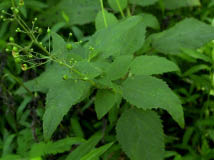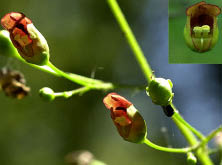Figwort Can Help You Cleanse The Skin |
|
|
|
Darrell Miller | 09/28/09 |
Date:
September 28, 2009 11:10 AM
Author: Darrell Miller
(dm@vitanetonline.com)
Subject: Figwort
 Figwort is the common name for some members of the Scrophulariaceae family, which is comprised mainly of herbs and small shrubs. These plants are distributed widely over all continents, with the family including few types of climbing plants and some parasitic and saprophytic forms.
Figwort is the common name for some members of the Scrophulariaceae family, which is comprised mainly of herbs and small shrubs. These plants are distributed widely over all continents, with the family including few types of climbing plants and some parasitic and saprophytic forms.
There are approximately 2800 species and 200 genera of Figword distributed worldwide. Many of these grow in the American Northwest. The name was derived from European species of Scrophularia, which is the common figwort. The plants are used to treat hemorrhoids, which were known as figs. Additionally, figworts were used to treat scrofula, which is a form of tuberculosis that is carried in the milk of infected cows.
Figwort finds the majority of its use in the treatment of skin problems. In a broad manner, it acts to help the body function well. This herb brings about a state of inner cleanliness. Figwort may be used for eczema, psoriasis, and any skin condition where there is itching and irritation. Part of the cleansing that comes from figwort is due to the purgative and diuretic actions that it possesses. The herb may be used as a mild laxative to treat constipation. It can also be used as a heart stimulant. For safety purposes, figwort should be avoided where there is any abnormally rapid heartbeat.
 The figwort family is characterized by irregular, bilaterally symmetrical flowers with four to five petal, joined to a calax and four to five petals, joined to a corolla. This forms a tube, with the petals flaring outward at the end. The lower ones form a down turned lip. The flowers are bisexual and are sometimes brightly colored. The leaves of the plant are alternate, opposite, and sometimes whorled. The fruit is typically a two-chambered capsule. Some common hemiparasites can be found in the figwort family. Among these are Indian paintbrush, owl’s clover, lousewort, and bird’s beak. These hemiparasites have green, photosynthetic leaves. A substantial portion of the parasite’s carbon comes from the host plant, which is parasitized from the roots.
The figwort family is characterized by irregular, bilaterally symmetrical flowers with four to five petal, joined to a calax and four to five petals, joined to a corolla. This forms a tube, with the petals flaring outward at the end. The lower ones form a down turned lip. The flowers are bisexual and are sometimes brightly colored. The leaves of the plant are alternate, opposite, and sometimes whorled. The fruit is typically a two-chambered capsule. Some common hemiparasites can be found in the figwort family. Among these are Indian paintbrush, owl’s clover, lousewort, and bird’s beak. These hemiparasites have green, photosynthetic leaves. A substantial portion of the parasite’s carbon comes from the host plant, which is parasitized from the roots.
Figwort is typically used as a skin medication for eczema, scabies, tumors, and rashes. The herb also provides hormone-like materials that are helpful in soothing the digestive organs. The herb has diuretic properties and can help to clean the kidneys. Figwort is sometimes used to treat circulatory disorders and may assist with the treatment of varicose veins. The herb is recommended for its ability to lower high blood pressure. Figwort can be used as poultice for ulcers, piles, scrofulous gland sin the neck, sores, wounds, and toothaches.
The leaves, stems, and roots of the figwort plant are used to provide alterative, anodyne, anti-inflammatory, antineoplastic, bitter, demulcent, diuretic, purgative, parasiticide, and stimulant properties. Primarily, figwort is extremely beneficial in dealing with abrasions, athlete’s foot, cradle cap, fever, impetigo, indigestion, restlessness, and skin diseases. Additionally, the herb is very helpful in treating anxiety, burns, cuts, eczema, hemorrhoids, insomnia, kidney problems, and light flow in menstruation, nightmares, and worms. For more information on the many beneficial effects provided by figwort, please feel free to contact a representative from your local health food store with questions.


